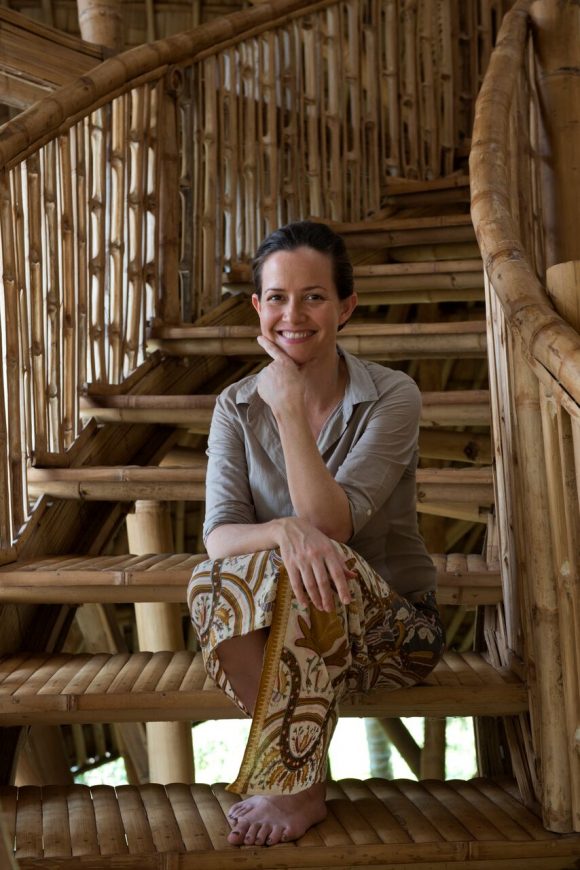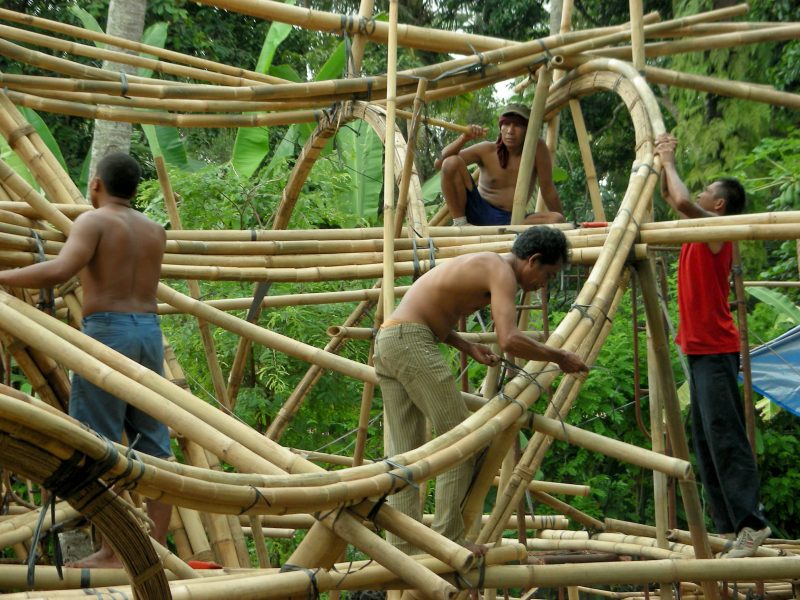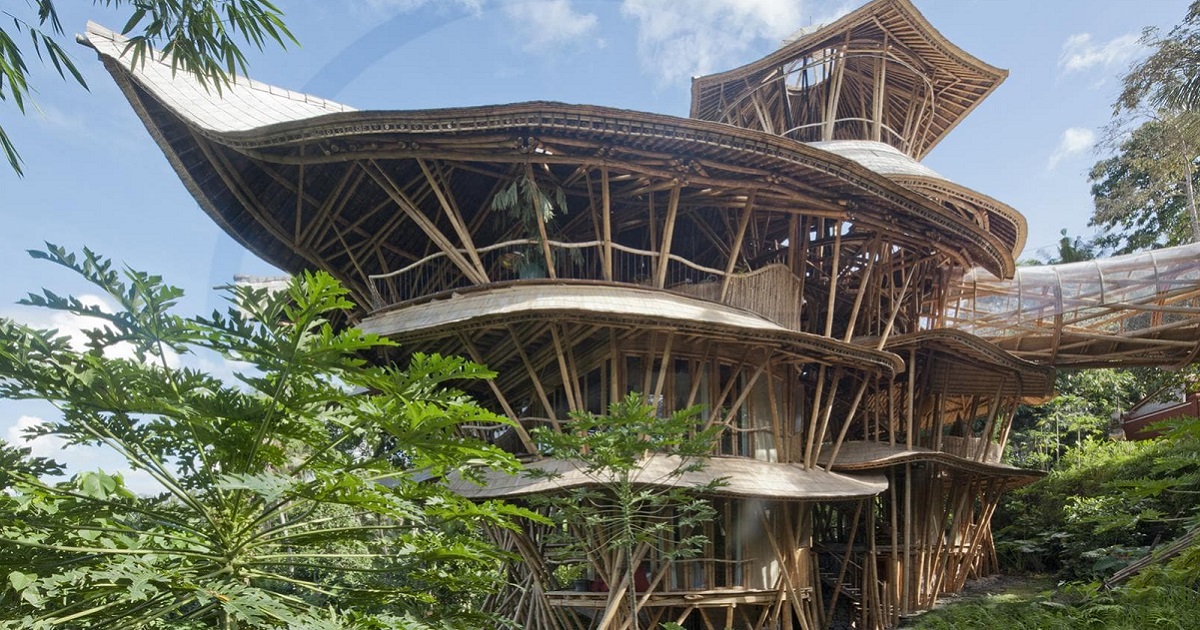Renewable Building Material
Sustainable and a good building material, bamboo’s the material of choice for IBUKU, a Bali-based architectural design company. Here, its founder tells Nisha K how she uses them to create stunning architectural structures. This article first appeared in In Focus issue 4 magazine.
The thought of a bamboo house is certainly fascinating and it lasts a lifetime. What’s more, bamboo is environmentally-friendly, sustainable, renewable, strong in tension as well as compression, and noted for its rapid growth. Bamboo houses are common in many parts of Southeast Asia where the plant grows in abundance.
At IBUKU, an architectural design company that handcrafts bespoke bamboo designs for boutique hotels, high-end resorts and hotels, restaurants, yoga centres and spas, the bamboo they use is carefully selected from the river valleys and mountains on Indonesian islands of Bali and Java. They are harvested from clumps that, once established, grow a new generation of shoots each year. It takes just a few months for a new bamboo shoot to reach its full height, and in three years it becomes timber ready for harvest.
IBUKU takes great care to ensure that only the mature poles are harvested, creating an incentive for the bamboo farmers to allow the younger shoots to grow to maturity for subsequent years’ harvests.
In the past, bamboo buildings were susceptible to termites and powder post beetle infestations that would eat the bamboo to dust. However, at IBUKU bamboo is treated with a boron solution, a naturally occurring salt solution that renders the bamboo indigestible to insects. It has a toxicity level just 1.5 times greater than that of regular table salt. The solution is re-used in a closed-loop system ensuring minimal impact on the immediate ecosystem.
Like any natural fibre, bamboo must be protected from the sun and rain. The dramatic overhanging roof and tilting structural columns are designed to protect the villas for the long-term. To prevent moisture, the structural beams are secured by steel and concrete to large river rock stones. These are in turn secured within the earth’s foundation by steel rods reaching down several meters, as determined by IBUKU’s team of structural engineers.
Birth of IBUKU
Raised in Bali, Elora Hardy was inspired by the highly skilled local craftsmen as well as her parents’ talented jewellery designs. She spent 14 years of her young adult life in the United States, where she received a degree in fine arts and went on to New York City to design prints for Donna Karan that would walk the world’s runways. In 2010, Elora left her successful career in the fashion world to carry on the incredible work of the design-build team that created the world-renowned Green School in Bali, founded by her father John Hardy.

The first structure at Green School was a bridge, connecting the two sides of the river valley campus. It stands as an outstanding example of what is possible when architects, engineers, designers, and craftsmen come together to build in a new way. The construction of Green School led to many innovations in bamboo architecture and engineering.
Elora and her team of designers and architects have until today built 60 new bamboo structures in Bali. 18 of these buildings now make up Green Village, a community of luxurious private homes neighboring the Green School. ‘What we are doing is reinventing the rules and standards of what a building can look like. These buildings are a testament to the power of bamboo and the possibilities of sustainable architecture. IBUKU continues to expand the potential of building exceptional bamboo structures’, adds Elora.
Joerg Stamm, a German builder who specialises in bamboo, was a key contributor in this process along with artist Aldo Landwher. Together they were responsible for developing many of the design aesthetics and engineering concepts used by IBUKU today. Joerg developed the concept of creating central basket-like towers to hold up larger buildings, as well as the lidi concept, giving us access to our signature curvilinear vocabulary.
The Strength of Bamboo
IBUKU uses bamboo because of its strength, beauty as well as flexibility, and also because with its four-year growth cycle and carbon sequestration capacity it’s the most environmentally conscientious building material conceivable. ‘In a world of retrofitting or re-designing traditional items and materials to be slightly less “bad”, we decided to wipe the slate clean and start fresh. Though bamboo has traditionally been used throughout Asia in short-term structures, new treatment methods have given it a capacity for a longer life,’ says Elora.
With very little attention, a bamboo shoot can become a structural column within three years, compared to 10-20 years for softwoods. Some species have been measured shooting skyward at two inches an hour or up to one and a half meters a day. Besides being sustainable, bamboo is also known for its unlimited possibilities and beauty.
The Balinese Community at IBUKU
Since the early days of Green School’s construction, IBUKU has collaborated with teams of skilled bamboo craftsmen, many of whom are descended from generations of wood and stone carvers. ‘We are proud to be continuing and evolving this age-old tradition so it can live on in Bali. Onsite, these craftsmen measure and replicate the bamboo model, building these structures almost entirely by hand’, Elora adds.
Bamboo entrepreneurship is also one of the key reasons to uplift the socio-economic status of the underprivileged and poor. ‘We work with many bamboo farming communities across Indonesia and are supporters of the work done by Arief Rabik,’ says Elora. Arief is the founder of Indobamboo and the Environmental Bamboo Foundation.
Bamboo has great potential for both economic empowerment and restoring degraded land. The bamboo used by IBUKU is carefully selected from the river valleys and mountains of the islands of Bali and Java in Indonesia. They are harvested from clumps that, once established, grow a new generation of shoots each year.
It takes just a few months for a new bamboo shoot to reach its full height, and in three years it becomes timber ready for harvest. IBUKU takes great care to ensure that only the mature poles are harvested, creating an incentive for the bamboo farmers to allow the younger shoots to grow to maturity for subsequent years’ harvests.

There are many challenges of using bamboo, but so are the opportunities. According to Elora, the main structure of the house is made of bamboo, however strong foundations are constructed from stone, concrete and steel. To ensure long-term weather resistance, roofs are made using bamboo shingles with an aluminium lining. Interior accents meanwhile are created using natural materials found in the local environment, including giant stone slabs, beaten copper in bathrooms, paper walls, and hammered brass details, all handmade by local artisans using traditional techniques.
Timber to Bamboo
Governments in Asian countries are encouraging farmers to grow bamboo trees instead of timber because of its advantages. With its three-year growth cycle and carbon sequestration capacity, it’s a uniquely efficient and responsible resource. Even sustainable timber can’t begin to compare with bamboo as a building material. Bamboo is also very affordable compared to timber and the duration where it can take 15 to 20 years for timber to be transformed into flooring. Bamboo functions essentially the same as wood but its lightness makes it – easy to handle, transport and store.
Advantages of Using Bamboo to Build Structures
10 advantages of bamboo that makes it a good building material:
- Bamboo’s strong natural fibre makes it superior to hardwood.
- Bamboo’s versatility makes it a good material for flooring, roofing, concrete reinforcement, scaffolding, piping and walls.
- Bamboo’s very flexible. When it grows it can be defined to grow into specific shapes.
- Its shock absorption capacity makes it a great building material for earthquake resistant houses.
- Bamboo houses can also stand hurricane of wind speed of up to 270 km/ph.
- It’s light in weight, making it easy to transport.
- When bamboo is properly maintained it can last as long as wood.
- Bamboo is cheap and readily available in areas where it’s cultivated.
- Transportation of bamboo is cheaper than other materials.
- Bamboo’s naturally waxy surface doesn’t require painting.
Source: Alternative Energy
Main photo by Tim Street Porter
